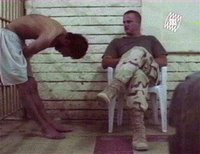![]()
Mark Shea's article "Toying With Evil" in the March issue of Crisis Magazine blasts conservative Catholics who want to make arguments for torture on the grounds that this is a new kind of enemy and a new kind of war, so quit being "sqeamish." It's a fiery read. It'll leave you saying, "dang, no he didn't!"
The basis of Shea's argument is Romans 3:8: Evil deeds may not be committed so that good may result.
But there's also no getting around the Catholic church's teaching:
Whatever violates the integrity of the human person, such as . . . torments inflicted on the body or the mind, attempts to coerce the will itself . . . all these things and others of their like are infamies indeed. They poison human society, but they do more harm to those who practice them than those who suffer from the injury. Moreover, they are supreme dishonor of the Creator.
or what Pope John Paul II said of torture:
"intrinsically evil"
Most poignant is Shea's argument that the slackening of norms against torture will lead to an increasingly slippery slope. He points out that the writing is already on the wall. "According to ABC News, 'U.S. military panels reviewing the detention of foreigners as enemy combatants are allowed to use evidence gained by torture in deciding whether to keep them imprisoned in Guntanamo Bay, Cuba' ( http://abcnews.go.com/Politics/wireStory?id/=299228 ).
So not only does this mean that residents of Camp X-Ray--as its affectionately called--have no rights whatsoever, but anything they say under the extreme duress of stress positions, sleep deprivation, temperature control, or whatever combo of the 25 interrogation tactics personally approved by president Bush for use at Gitmo, can be used against them.
Read any reputable expert on interrogation and they'll tell you that torture is ineffective in "extracting"--lovely word--"intelligence"--another lovely word--from a suspect. As one suspected IRA detainee said of his torture at the hands of British para-military interrogators in 1971, "I would have told them I was in the cradle." Translation for Americans: I would have told them I was present at the birth of Jesus Christ just to get them to stop.
What's apropo about this Northern Irishman's testimony is that his torture, and the torture of several other men, consisted of the same basic techinques currently used by the Bush administration. These men, known today in torture literature as the "Hooded Men," were arrested without being charged, hooded, taken by helicopter to an unknown location, and made to stand "spread-eagle" for several days with their hands high against the wall in front of them. The entire time, they were subjected to an unrelenting hissing sound. No other sounds were audible--many said this was the most horrific part of the ordeal. They were not allowed to remove their hands or they were beaten. They did not sleep for a week. Most were not allowed to use the toilet. One man said that during the ordeal he became so deranged that he tried to throw himself down against a pipe at his feet hoping to hit his head and kill himself.
When the men were finally released, without charge, most of the men had swelling in their feet and hands that caused them chronic problems for years afterwards. One man reported afterwards that he did not remember that he was married and had children until someone reminded him.
peace,
DG
ps Those interested in reading more about the "Hooded Men" and other instances of institutionalized torture should check out John Conroy's book, "Unspeakable Acts, Ordinary People."


